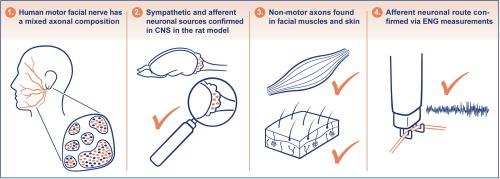Journal of Advanced Research ( IF 11.4 ) Pub Date : 2022-04-22 , DOI: 10.1016/j.jare.2022.04.009 Vlad Tereshenko 1 , Udo Maierhofer 1 , Dominik C Dotzauer 1 , Gregor Laengle 1 , Martin Schmoll 2 , Christopher Festin 1 , Matthias Luft 1 , Genova Carrero Rojas 3 , Olga Politikou 1 , Laura A Hruby 4 , Holger J Klein 5 , Steffen U Eisenhardt 6 , Dario Farina 7 , Roland Blumer 3 , Konstantin D Bergmeister 8 , Oskar C Aszmann 9

|
Introduction
Neuromuscular control of the facial expressions is provided exclusively via the facial nerve. Facial muscles are amongst the most finely tuned effectors in the human motor system, which coordinate facial expressions. In lower vertebrates, the extracranial facial nerve is a mixed nerve, while in mammals it is believed to be a pure motor nerve. However, this established notion does not agree with several clinical signs in health and disease.
Objectives
To elucidate the facial nerve contribution to the facial muscles by investigating axonal composition of the human facial nerve. To reveal new innervation pathways of other axon types of the motor facial nerve.
Methods
Different axon types were distinguished using specific molecular markers (NF, ChAT, CGRP and TH). To elucidate the functional role of axon types of the facial nerve, we used selective elimination of other neuronal support from the trigeminal nerve. We used retrograde neuronal tracing, three-dimensional imaging of the facial muscles, and high-fidelity neurophysiological tests in animal model.
Results
The human facial nerve revealed a mixed population of only 85% motor axons. Rodent samples revealed a fiber composition of motor, afferents and, surprisingly, sympathetic axons. We confirmed the axon types by tracing the originating neurons in the CNS. The sympathetic fibers of the facial nerve terminated in facial muscles suggesting autonomic innervation. The afferent fibers originated in the facial skin, confirming the afferent signal conduction via the facial nerve.
Conclusion
These findings reveal new innervation pathways via the facial nerve, support the sympathetic etiology of hemifacial spasm and elucidate clinical phenomena in facial nerve regeneration.
中文翻译:

新发现的面神经轴突类型揭示了面部神经支配的补充神经通路
介绍
面部表情的神经肌肉控制完全通过面神经提供。面部肌肉是人体运动系统中最精细调节的效应器之一,可协调面部表情。在低等脊椎动物中,颅外面神经是混合神经,而在哺乳动物中,它被认为是纯运动神经。然而,这一既定观念与健康和疾病的一些临床症状并不一致。
目标
通过研究人面神经的轴突组成来阐明面神经对面部肌肉的贡献。揭示运动面神经的其他轴突类型的新神经支配通路。
方法
使用特定的分子标记(NF、ChAT、CGRP 和 TH)区分不同的轴突类型。为了阐明面神经轴突类型的功能作用,我们使用选择性消除来自三叉神经的其他神经元支持。我们在动物模型中使用逆行神经元追踪、面部肌肉三维成像和高保真神经生理学测试。
结果
人类面神经显示只有 85% 的运动轴突混合。啮齿动物样本揭示了运动神经、传入神经和令人惊讶的交感神经轴突的纤维组成。我们通过追踪 CNS 中的起源神经元来确认轴突类型。面部神经的交感神经纤维终止于面部肌肉,表明自主神经支配。传入纤维起源于面部皮肤,证实了传入信号通过面神经传导。
结论
这些发现通过面神经揭示了新的神经支配通路,支持了面肌痉挛的交感神经病因,并阐明了面神经再生的临床现象。











































 京公网安备 11010802027423号
京公网安备 11010802027423号